|

The Darwinian gardener working on the new bed below the P. G. hydrangea
click images for larger views
back to main garden page
|
Had to drive to Southampton for a dentist, so rewarded myself by a trip to the best garden center in town: plants on sale Mondays, especially after the fourth.
There on the sidewalk were the inevitable flats of annuals – impatience not yet unloaded to renters & showy estates, but also a few perennials reduced as past theirbloom & less useful for instant landscaping:
Aconitum cammarum (monkshood) looked like a great find for the front path, deadly poison so not bothered by deer, to stand tall by the cinnamon ferns & the freshly moved hellebore blooms now, whiteish flowers edged in blue, fat seed pods promising more; name in old Latin Pliny though meaning obscure (likes some shade, so may not work);
Dicentra spectabilis gallon pot: can't get too much bleeding heart.
Papaverum atlanticum i.e. an unusual poppy with long, slender seed caps already dry & rattling, so another promise of more;
Thymus ibukiensis, a creeping thyme with lively flowers, to start a fragrant walk from outdoor shower to pool, turns up on Google as ‘Mongolian Thyme’, Thymus quinquecostatus ibunkiensis, that species name nurseries omit, 'five ribbed', but ibuki, who or where???;
Geranium maculatum, sc. ‘Spotted cranesbill’, which should help fill in the new bed I've been clearing behind the deck under the P. G. hydrangea;
|
Euphorbia x ‘Mini Martini: search gets a flood of adds for glassware, then the botanical note: “characterized by its compact and mounded plant habit; freely branching habit; dense and full plant form; freely flowering habit; and green-colored floral bracts and dark purple-colored nectaries” – thought it could look good in the bog border.
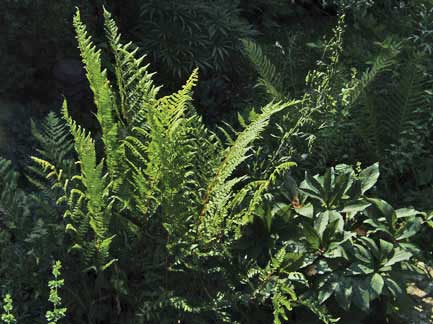
(above) Aconitum cummarum & Osmunda cinnomomea over the newly placed Helleborus Orientalis.
(right)Eupatorium perfoliatum self seeded.
|
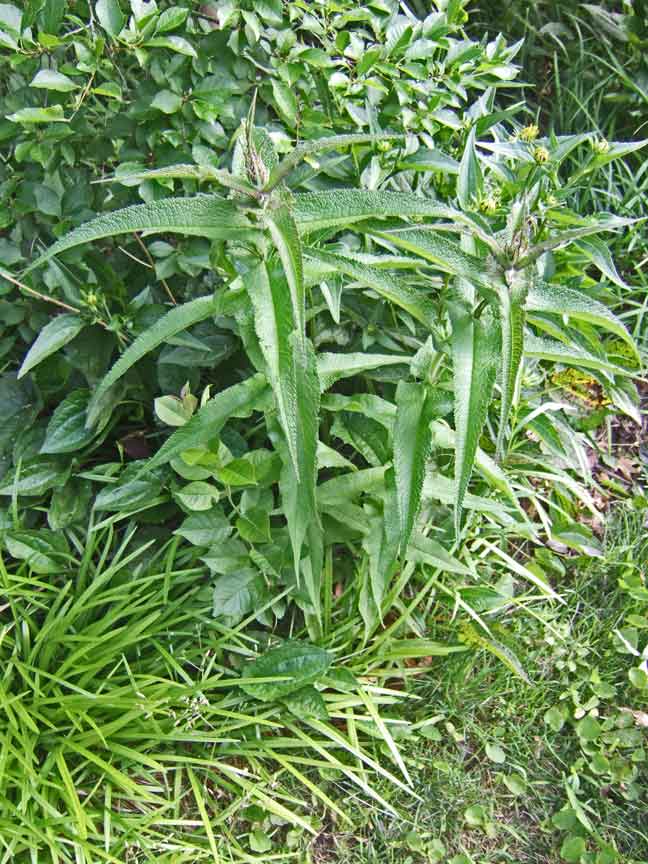
|
Waited till nearly four for cooler air, then put the monkshood out front where it looked good, though perhaps too crowded. Its color a bit more blue white than A. pyrenaicum in the cloister garden at Middelburg, from which my seeds have not yet sprouted. Terribly pot bound, so had to tease out roots, as also for the euphorbia & the thyme.
In the bed below the PG put the bleeding heart at the back; it will be up & blooming before the hostas leaf out next spring.
In the southern part of the same bed to place the cranes bill, I had to clear more frais des bois that had buried the deutzi a in the far corner, also overrun by some tough Japanese iris that nearly broke the spade. I added them to the island that divides the near lawn from the field, hacking them a trench the matted turf & Queen Anne’s lace.
Cleared that bed all the way back to the lattice below the deck, getting rid of grasses & golden rod & parsnips. Set the cranesbill in the midst of a bare patch.
The poppy seemed not to fit well in any part of the bed, I put it on the pool's south border, getting rid of more fruitless frais & now Lobelia siphylitica, finding a lost rose.
The euphorbia with its bronze color looked fit for a bare spot over on the bog border, where I had to grub out some invasive yellow flags that didn’t really belong there, so I pried them out (some of them broke my favorite W. P. A. trencher last year) & took them over to a bed under a spreading winterberry in the far southern border.
First thing I saw there were two shoots of phragmites, which last year had colonized the space. I had missed a few last year when I grubbed out the tubular white rhizomes. Also brought back for the bog some Eupatorium perfoliatum that is multiplying nicel: a desirable volunteer, unlike the bittersweet with its orange roots & insidious vines. Also spotted an isolated astilbe about to flower, so brought that back too & placed it with the E. perfol on the bog border. Also the birds had planted some cedars under the winterberry, so I brought them back to place along the west edge, where a row of Leland cypresses planted much too close to each other (not by us) is dying back so that new cover required, which we hopt to provide with cedars from the property itself.
It was getting dark & I still hadn’t planted the thyme or the cedars, but did have a cart full of candidates for compost.
|
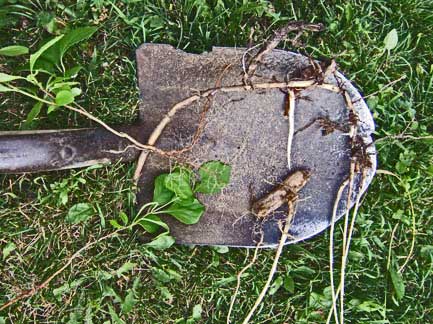 (Above) Phragmites rhizomes & to left, seedling bittersweet with its typical orange roots. (Above) Phragmites rhizomes & to left, seedling bittersweet with its typical orange roots.
(Left) Cimicifuga racemosa & lily.
|
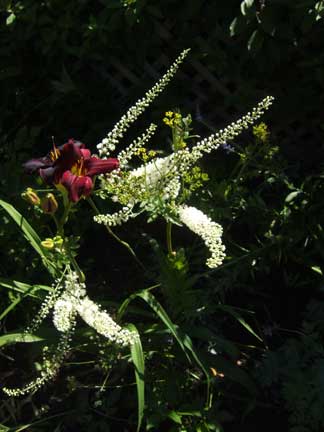 |
|
| Hydrangea quercifolia ('Oakleaf')& Cimici fuga racemosa ('Bugbane') in south rock garden |
Filipendula |
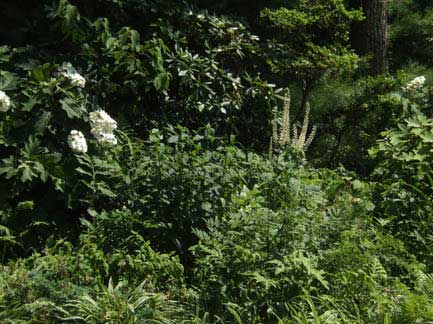 |
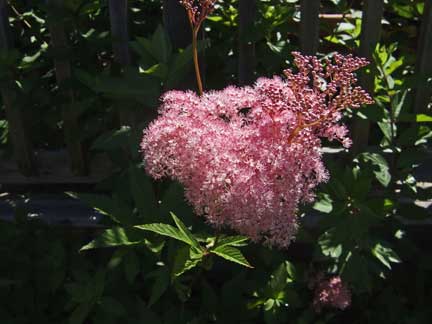 |
I rigged a hose to water in what I had planted & hoped for a shorter session the next day. Not to be. Going back to sift more compost, I fastended on how the frais de bois were choking out our prize lilies from Gaylordsville (on the Housatonic river, near Kent, western edge of Connecticut). I began pulling them out, also with catnip, so as to make a space around the lilies & around the Echinacea, ‘cone flowers’ that are taller & more abundant than ever before. Where the frais grew, I discovered, the voles tunnel: figured that by exposing their holes & tamping earth around plants, I could avoid some of he worse effects. By the way, rescued a mouse from the pool; if it had been a vole, varmit would have suffered the fate of the potato & Japanese beetles that I have to seine almost every morning. As it was, I caught the mouse in the seine & dumped it into the woods. Of course they do carry ticks & do nest in my sheds, shredding any cloth items to make nests, but they are warm blooded, even anthropomorphic (but let’s not go there: a member of my high school class wa nicknamed ‘Mouse’ & another ‘Ratsy’).
Was getting ready to plant the thyme near the edge of the yard, between some self-seeded columbines that I wanted to save, when I noticed in the rock garden next to the house that my volunteer corydalis was drooping. Its roots were muched & rotten. The ginger was reduced to fragments, miniature hostas rootless, & two clumps of Dicentra eximia & a plant with its flowers in yellow umbels had usurped the place, overwhelming one of my favorites, which scarcely survived – a plant that I got from Holgar Winenga & that did well last year: heart shaped leaves, with white striations, purplish under leaf & flower a bit like Jack in the pulpit.
I decided on major replanting: took out the umbelifer & the bleeding hearts, a intact clump of slender green hosta & discovered that sweet woodruff & violets had colonized right up to the stems the Paeonia obovata, which is the dominant feature of the bed. I cleared out the violets to free its stems & leave space for the seeds to fall, since the plant itself came from a seedling. Then I took the glossy ginger that was lost back there under the peony & brought it down to line up along the right side, under the Jacob’s ladder (polemonium) that flowered so well this year & seems untouched by voles. Replanted the hostas & made a place at the center for the rarity from Holgar, hoping it will recover.
Had to make a place for the bleeding heart & its ally, so spotted some ‘gooseneck’(Lysimachia clethroides) with its white nodding flowers but too close to the new euphorbia & not really fit for the upper border of the bog. So I took that out & put it over across under the winterberry with the flags moved yesterday.
Planted the bleeding heart.
Then put in the thyme at last. Decided to stop postponing fertilizer for the roses. Mixed a gallon & went to the north gate. Applying what I had just been observing about excessive cover, I started removing sweet woodruff & ajuga from around the rose. I poked the soil thinking to make a channel for the fertilizing solution. My finger went right in. The voles had been there already. More poking showed that they were excavating all around the roots, so I cleared & tamped & cleared some more & tamped some more, also around the neighboring clematis. The uprooted ground cover I planted in the somewhat deserted space just outside the gate between the bicycle shed & the shower.
Oh, & I sifted compost to fill a pot for anemone that Gail got free at the garden center & filled another pot with a rooted stem of Brugmannsia & some four o’clocks that noone remembers having planted, also rescued a prize day lily from the south rock garden outside the fence, to save it from deer. Out there the oak-leaf hydrangea are forming an ebullient backdrop, where the pink azaleas were two months ago, complemented by the tall white spires of Cimicifuga racemosa that wave in the wind. The paw paws making lots of glossy new leaves. Bowman’s root beginning to set seed, but too crowded by Cimicifuga cordifolia, which looks very prosperous, but probably ought to be moved down the bed’s center, replacing some sensitive ferns. The whole bed looks much better since I composted the host of fever few, leaving white to the ballet of the Cimicifuga racemes & arching hydrangeas behind.
Finding those voles around the roses & a lot also near the cone flowers & lilies in lower bog dictates clearing a lot more of the frais & other creepers, leaving more open space to the main plants, especially peonies. The present fullness resulted from the way we started: moving in as much as we could & dividing it around, to see what would take. Now we know, so selectivity kicks in, refereeing the Darwinian grab for water & light.
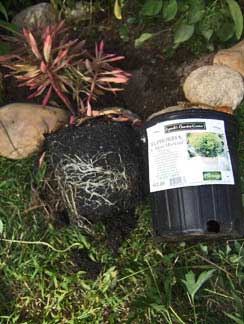 |
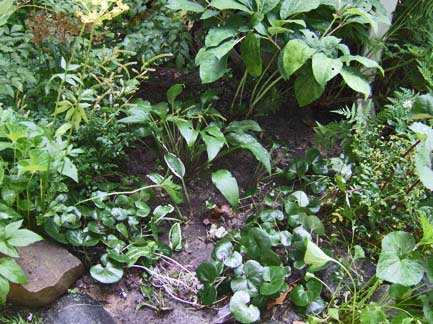 |
| Pot bound Euphorbia before teasing out the roots |
Bed below P. obovata replanted, hostas reset, ginger to left & right, remnants of mystery plant center front, sweet Cecily to right back. |
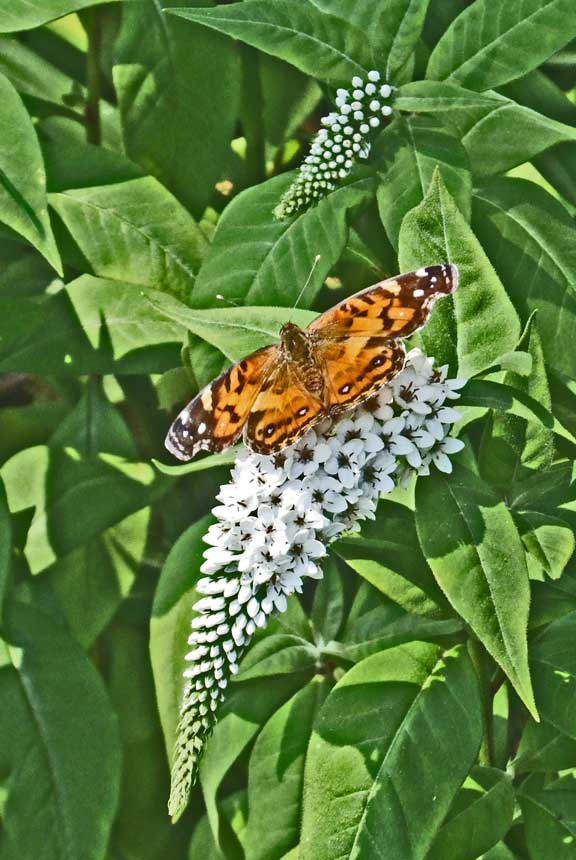 |
Vanessa virginiana(American Painted Lady) & Lysimachia clethroides (i.e. 'Loose strife that looks like [Greek oid-<< *woid, cf. Latin vid- & German Wiss, English wit, wise, wisdom & by metonymic specialization, sc. semantic degeneration, witch, wizard] Summer Sweet = Clethra') |
back to main garden page
|

